You’ll craft authentic African jewelry by mastering traditional techniques that span over 10,000 years, using sacred materials like recycled glass beads, brass, copper, shells, and natural fibers. Each material carries deep spiritual significance—shells connect to life forces while metals symbolize strength and status. Learn ancient beadwork methods, lost-wax casting, and symbolic patterns like triangles for stability and spirals for life’s cycles, while respecting cultural heritage through genuine collaboration with local artisans and understanding the profound meanings behind every design choice.
Understanding Sacred Materials and Their Cultural Significance
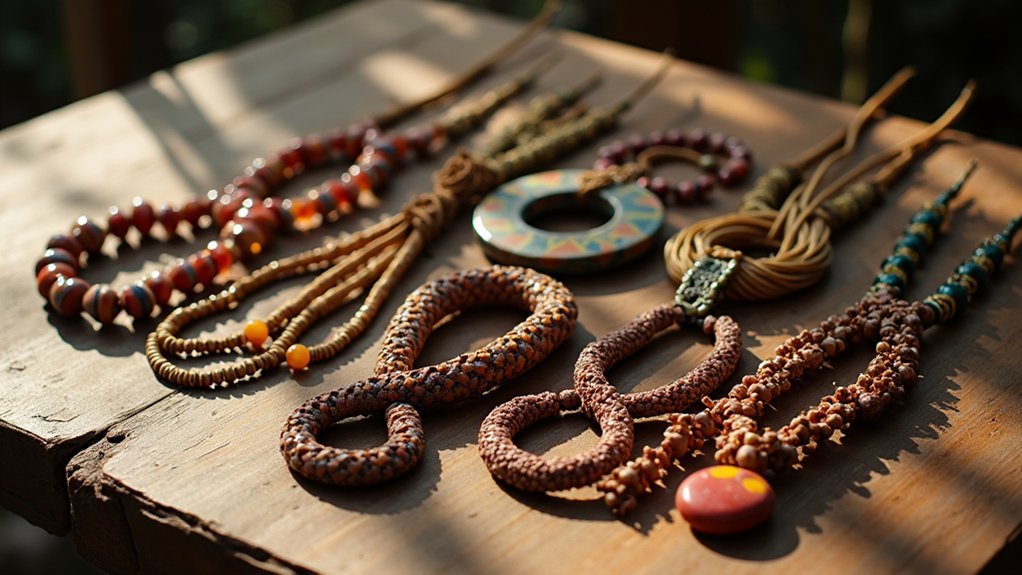
When you examine authentic African jewelry, you’ll discover that each material carries profound spiritual and cultural meaning beyond mere decoration. Sacred materials like recycled glass beads symbolize sustainability and resourcefulness, reflecting community values through vibrant colors.
Each sacred material in authentic African jewelry tells a deeper story of spiritual meaning, cultural heritage, and community values beyond simple adornment.
Shells connect you to oceanic life forces, while brass and copper demonstrate strength and social status through intricate craftsmanship.
Natural soapstone and wood hold deep cultural significance, particularly in ceremonial pieces that convey protection and prosperity messages.
Understanding these sacred materials enhances your appreciation of authentic designs, as each component tells stories about artisan heritage and community identity.
You’ll find that respectful use of traditional materials creates jewelry that honors African cultural traditions while maintaining spiritual authenticity.
Mastering Ancient Beadwork Techniques Passed Down Through Generations
While modern jewelry-making relies heavily on machines and mass production, African beadwork tradition remains deeply rooted in hand-crafted techniques that stretch back over 10,000 years.
You’ll discover that mastering these ancient methods requires understanding how craftspeople originally used ostrich eggshells, shells, and animal bones to create intricate designs.
When you learn traditional jewelry techniques, you’re accessing knowledge that’s been carefully preserved through generations. Each pattern you create carries specific cultural meaning, representing tribal identity and social status within African cultures.
You’ll need to practice the precise threading and spacing that transforms simple materials into symbols of wealth and prestige.
Today, you can support cultural preservation by learning these authentic methods, helping guarantee these invaluable traditions continue thriving in contemporary communities.
Traditional Metal Working Methods Using Brass and Copper
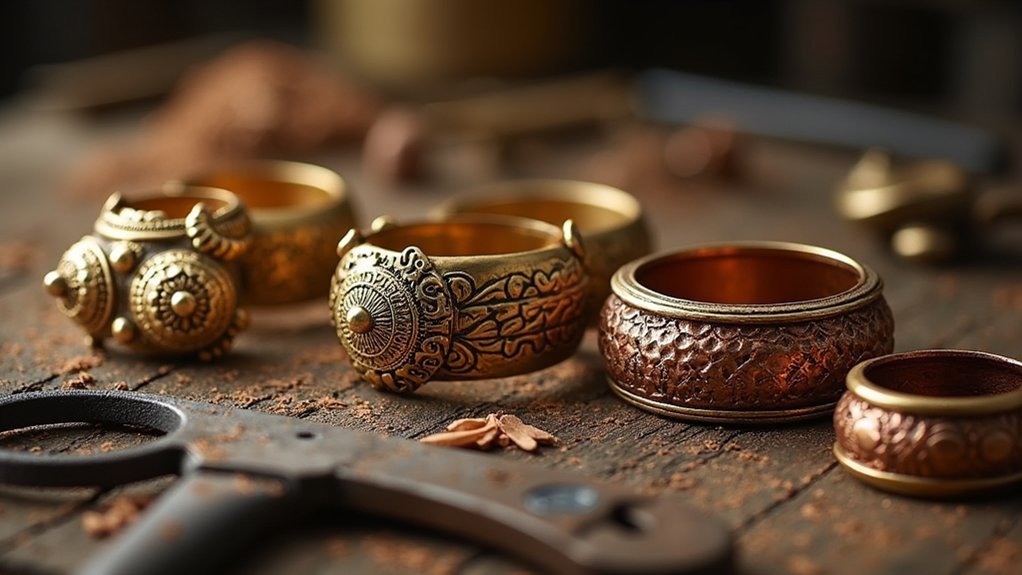
Beyond the intricate world of beadwork lies another cornerstone of African jewelry artistry: the masterful manipulation of brass and copper that’s defined metalworking traditions across the continent for centuries.
You’ll discover that traditional African jewelry relies heavily on these metals’ unique properties. Brass and copper offer exceptional malleability, allowing you to craft intricate designs while maintaining remarkable durability.
| Metal | Properties | Common Uses |
|---|---|---|
| Brass | Durable, malleable | Tribal adornments, ceremonial pieces |
| Copper | Reddish hue, symbolic | Beads, bangles, pendants |
| Alloys | Enhanced properties | Strengthened jewelry components |
Lost-wax casting remains your primary technique for creating detailed pieces. You’ll find this method particularly prevalent among Ashanti artisans, where patterns reflect deep cultural significance. Modern practitioners increasingly embrace eco-friendly sourcing practices, ensuring traditional metalworking methods remain sustainable while preserving ancestral craftsmanship techniques.
Incorporating Symbolic Patterns and Geometric Designs
As you shift from metalworking techniques to surface decoration, the symbolic patterns and geometric designs adorning authentic African jewelry emerge as profound storytellers of cultural identity.
When you’re creating beaded jewelry or engraving metal surfaces, understanding these patterns’ meanings transforms your work from mere decoration to cultural expression.
Research the symbolism behind common geometric shapes to honor their heritage:
- Triangles representing strength and stability in community structures
- Diamonds symbolizing fertility and abundance in harvest seasons
- Spirals depicting life’s cyclical nature and spiritual growth
- Interlocking patterns showing unity and interconnectedness
- Zigzag lines representing water, lightning, or ancestral pathways
Mastering various beading techniques allows you to creatively interpret these motifs while respecting their cultural significance.
You’ll craft pieces that authentically reflect traditional values of protection, prosperity, and social status.
Hand-Crafting Techniques for Working With Natural Fibers and Shells
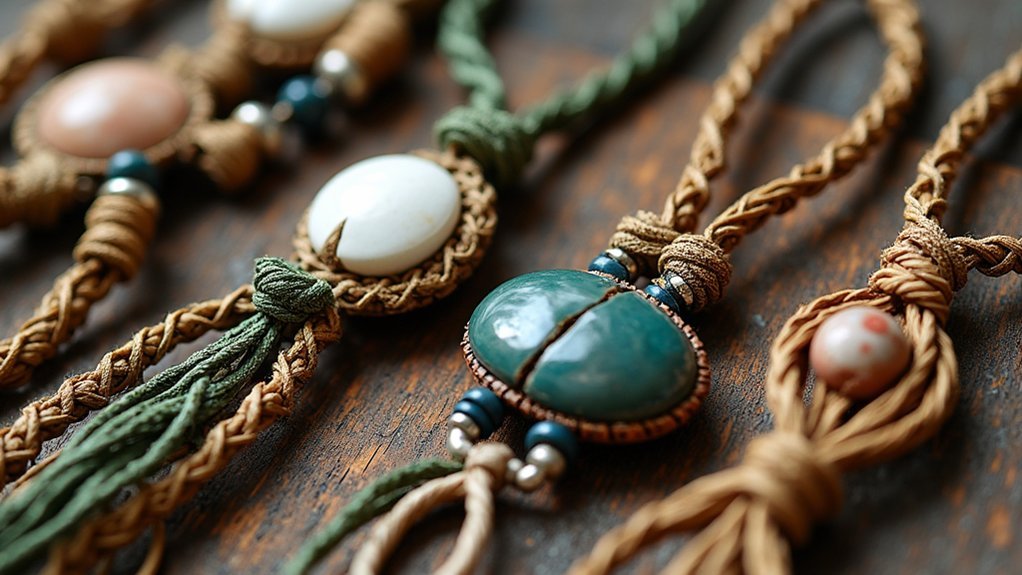
You’ll master authentic African jewelry creation by first preparing your natural fiber materials through careful selection and conditioning of cotton, jute, or sisal strands.
Next, you’ll choose and prepare shells by cleaning, sorting, and drilling precise holes that accommodate your specific design requirements.
Finally, you’ll apply traditional weaving and binding techniques like coiling and knotting to transform these raw materials into distinctive pieces that honor cultural heritage.
Preparing Natural Fiber Materials
Several fundamental steps transform raw natural fibers into workable materials for authentic African jewelry creation.
You’ll need to clean and dry your fibers thoroughly to enhance durability and prevent degradation during crafting. This preparation process is essential for maintaining the integrity of your traditional craftsmanship.
When preparing natural fibers like sisal, raffia, and cotton, follow these vital steps:
- Remove dirt, debris, and damaged portions from raw fibers
- Wash fibers gently in clean water to eliminate impurities
- Dry completely in shade to prevent color fading and brittleness
- Sort fibers by length and quality for consistent results
- Bundle prepared fibers for easy access during crafting
Properly prepared materials guarantee your jewelry pieces reflect authentic African artistry while maintaining structural integrity throughout the creation process.
Shell Selection and Preparation
When selecting shells for authentic African jewelry, consider durability, color variations, and surface textures that’ll complement your natural fiber materials.
Traditional African artisans prioritize shells that withstand daily wear while showcasing natural beauty. Look for specimens with rich colors and interesting patterns that enhance your overall design aesthetic.
Clean your chosen shells using mild soap and warm water, then dry them thoroughly to reveal their natural shine. This preparation step guarantees they’re ready for crafting.
When drilling holes for stringing, use specialized drill bits and work slowly to prevent cracking. The precision you maintain during shell selection and preparation directly impacts your finished piece’s authenticity and durability, honoring time-tested traditional African jewelry-making methods.
Traditional Weaving and Binding
Although traditional weaving techniques have evolved over centuries, mastering the fundamental methods of working with natural fibers and shells remains essential for creating authentic jewelry pieces.
You’ll discover that African communities have perfected the art of binding materials like sisal, cotton, and raffia into flexible, durable designs that carry deep cultural significance.
When practicing traditional weaving, focus on these core techniques:
- Coiling method – Wind natural fibers together to form base shapes for embellishment
- Shell integration – Weave shells directly into fiber patterns for structural support
- Bead binding – Secure beads using inherited knotting techniques from your community
- Texture creation – Layer different materials to achieve intricate visual patterns
- Sustainable sourcing – Use locally-gathered materials following environmental practices
These labor-intensive methods require patience and dedication to master properly.
Color Theory and Traditional African Palette Applications
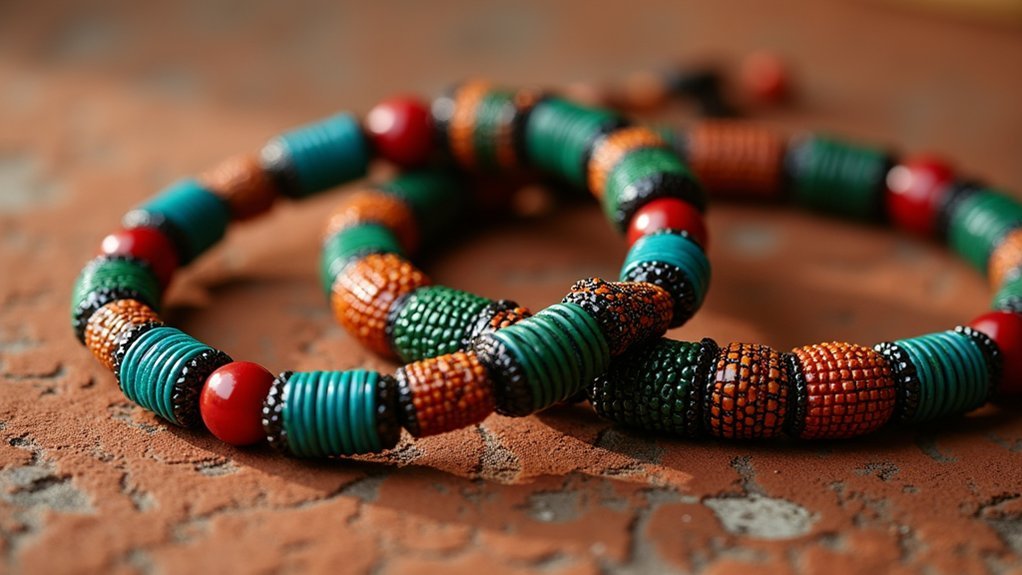
When you’re creating authentic African jewelry, you’ll discover that each color carries profound sacred meanings rooted in centuries of cultural tradition.
You can’t simply choose colors based on personal preference—red might symbolize life force and passion, while yellow represents wealth and fertility in many African cultures.
Understanding these sacred associations helps you create harmonious palettes that honor the spiritual significance behind every vibrant bead and carefully chosen hue.
Sacred Color Meanings
Since color serves as a universal language that transcends spoken words, traditional African jewelry harnesses this powerful communication tool to convey sacred meanings and cultural narratives.
When you’re crafting authentic African jewelry, you’ll discover that each hue carries profound spiritual significance rooted in centuries of tradition.
Understanding these sacred meanings transforms your designs from mere decoration to powerful cultural expressions:
- Red symbolizes strength, courage, and sacrifice – perfect for warrior-inspired pieces
- Green represents fertility, prosperity, and life force energy
- Yellow embodies wealth, wisdom, and divine connection
- Blue signifies peace, tranquility, and spiritual protection
- Bold combinations like red, yellow, and green create visual narratives that speak to ancestral stories
You’ll find that respecting these traditional color meanings guarantees your African jewelry resonates authentically with its cultural heritage.
Harmonious Palette Creation
While traditional African color meanings provide the foundation, mastering color theory elevates your jewelry designs from culturally appropriate to visually stunning.
You’ll want to understand how complementary colors create striking contrasts that mirror traditional African aesthetics. Bold reds, yellows, greens, and blues aren’t just randomly used—they’re strategically combined to convey specific emotions and messages while maintaining cultural identity.
Experiment with different bead arrangements and sizes to achieve unique visual effects. Larger beads in dominant colors should anchor your design, while smaller accent beads create rhythm and movement.
Consider how colors interact: warm yellows enhance red coral, while cool blues make green malachite pop. These thoughtful combinations guarantee your jewelry reflects both authentic African heritage and sophisticated design principles.
Preserving Authenticity While Respecting Cultural Heritage
Although the beauty of African jewelry captivates collectors worldwide, you can’t truly appreciate its value without understanding the deep cultural significance woven into every design.
Preserving cultural heritage while creating authentic pieces requires genuine respect for local communities and their traditions.
To maintain authenticity in your jewelry making:
- Research the symbolic meanings behind specific motifs and materials before incorporating them
- Partner directly with local artisans to learn traditional techniques firsthand
- Use sustainable practices like recycled materials that align with traditional craftsmanship values
- Collaborate with cultural experts to guarantee your designs honor their intended narratives
- Always acknowledge and credit the cultural origins of the techniques you’re using
This approach prevents appropriation while fostering meaningful connections with African artisan communities.
Frequently Asked Questions
What Did Ancient African Civilizations Use to Create Jewelry?
You’d find ancient African civilizations used ostrich eggshells, shells, animal bones, and metals to create jewelry. They’d craft beads from these natural materials, incorporating them into pieces that symbolized protection, wealth, and social status.
What Is the Most Popular Jewelry in Africa?
You’ll find beaded jewelry is Africa’s most popular adornment, especially vibrant glass beads from Ghana’s Krobo and Ashanti tribes, coral beads from coastal regions, and elaborate brass pieces featuring traditional symbols.
What Materials Are Used in African Jewelry?
You’ll find African jewelry crafted from natural materials like colorful recycled glass beads, shells, wood, brass, copper, bone, and soapstone. These materials aren’t just decorative—they’re chosen for cultural significance and symbolism.
What Are Traditional African Beads Made Of?
You’ll find traditional African beads crafted from glass, clay, wood, bones, metals, and shells. Recycled glass beads from Ghana transform waste into vibrant jewelry, while handmade clay beads showcase intricate designs and cultural significance.
In Summary
You’ll discover that creating authentic African jewelry isn’t just about technique—it’s about honoring centuries of cultural wisdom and artistic expression. As you master these traditional methods, you’re becoming a guardian of ancestral knowledge, ensuring these sacred practices continue thriving. Remember, you’re not just crafting jewelry; you’re weaving together stories, symbols, and spirituality that connect past generations to future ones. Approach each piece with reverence and deep cultural respect.

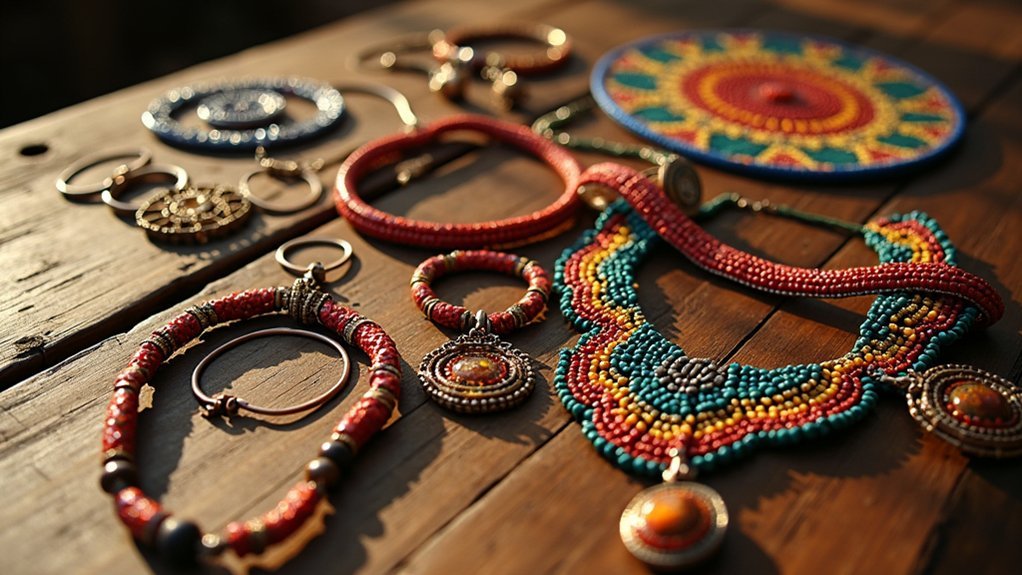
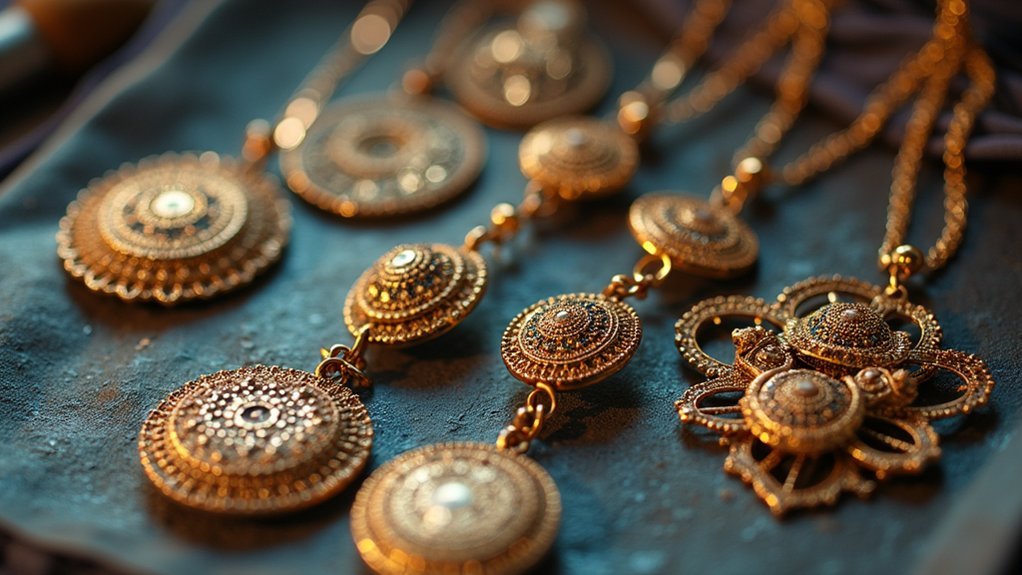
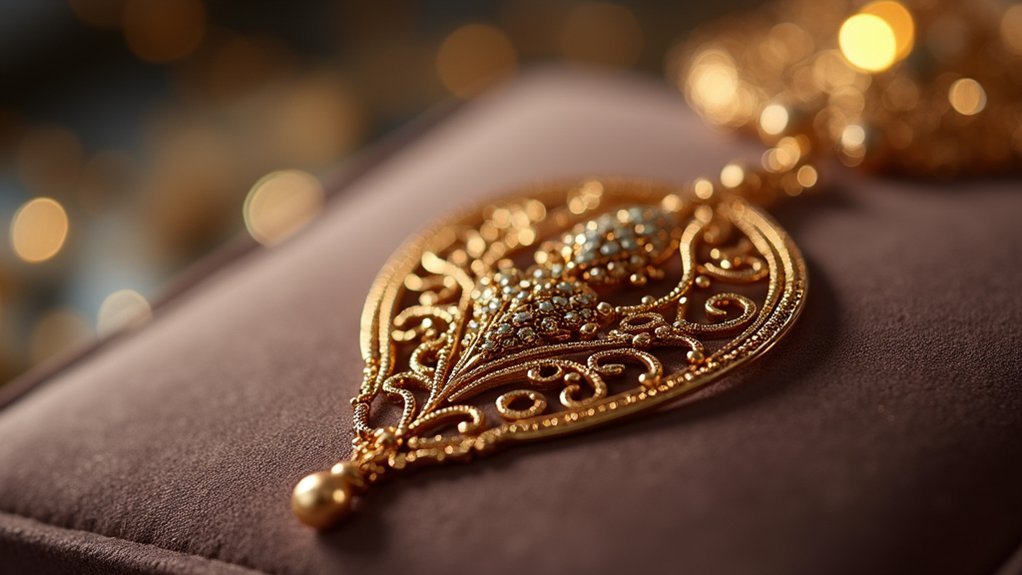

Leave a Reply